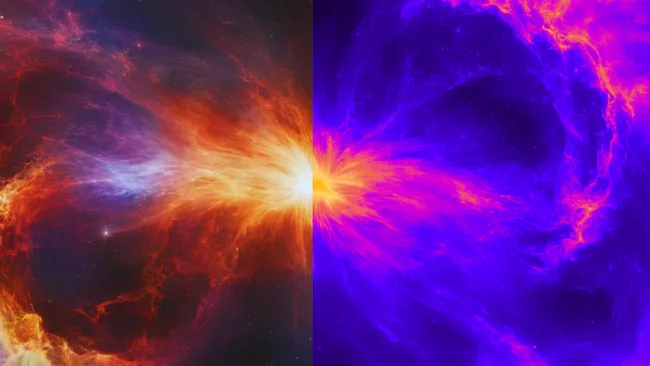Dark matter remains one of the greatest mysteries in modern science, comprising over 85% of the universe’s mass, yet invisible and enigmatic. A new theory involving “dark photons” could illuminate the hidden mechanisms of the dark sector and its interactions during the cosmic dawn. This breakthrough promises to reshape our understanding of galaxy formation and dark matter’s role in shaping the universe.
What Are Dark Matter and Dark Photons?
Dark matter, despite its invisibility, plays a crucial role in the universe. It doesn’t interact with light or electromagnetic radiation, making it undetectable through conventional means. Yet, its gravitational pull has shaped galaxies, clusters, and cosmic structures.
Dark photons, theoretical counterparts to photons, introduce a revolutionary idea. Unlike ordinary photons that interact with atomic matter, dark photons primarily interact with dark matter. This interaction could leave subtle, yet detectable, traces that scientists are now on the brink of identifying.
The Cosmic Dawn: A Crucial Era for Discovery
The cosmic dawn, a period spanning 500 million years after the Big Bang, marked the birth of the first stars and galaxies. This era serves as a cosmic laboratory to study dark matter’s role in galaxy formation. Early in this epoch, the disruptive forces of supernovae and stellar winds were minimal, allowing the effects of dark matter to shine through.
By studying this era, researchers hope to uncover how dark matter influenced the formation of galaxies and cosmic structures. The cosmic dawn provides a pristine window into understanding the small-scale behavior of dark matter, untainted by later cosmic processes.
The Theory of Dark Acoustic Oscillations
One of the most compelling theories in this field involves dark acoustic oscillations. These ripples, formed by interactions between dark matter and dark photons, resemble sound waves propagating through the universe’s early plasma. Unlike sound waves, however, these oscillations occurred in the density distributions of dark matter.
These oscillations could have created patterns in the density of matter, influencing where galaxies formed. Regions of higher density may have accelerated star formation, while less dense areas slowed it down. These patterns, if detected, would provide direct evidence of dark photon interactions and their influence on cosmic evolution.
Tools and Techniques for Detecting Dark Photon Interactions
To uncover these traces, scientists rely on advanced tools like the Hydrogen Epoch of Reionization Array (HERA), the Low-Frequency Array (LOFAR), and the Square Kilometer Array (SKA). These radio telescopes are designed to detect faint signals from the early universe, offering unparalleled insights into the cosmic dawn.
HERA, for instance, analyzes radio signals from neutral hydrogen, the building block of early galaxies. By mapping these signals, researchers can identify subtle density fluctuations caused by dark acoustic oscillations.
Implications for Understanding Dark Matter and the Universe
Detecting dark photon interactions would revolutionize our understanding of the universe. For decades, dark matter has been studied indirectly through its gravitational effects. Dark photons offer a direct pathway to explore the dark sector, potentially revealing its properties and behaviors.
The Future of Dark Photon Research
The journey to uncovering dark photon interactions is just beginning. As telescopes like SKA become operational, the precision of observations will improve dramatically. These instruments will allow scientists to map the cosmic dawn in greater detail, identifying the subtle imprints of dark acoustic oscillations.
Future research aims to quantify the full extent of dark photon interactions and their impact on galaxy formation. Collaborations between cosmologists, particle physicists, and astronomers will be crucial in bridging gaps between theoretical predictions and observational evidence.
Conclusion
The potential discovery of dark photons and their role in the cosmic dawn represents a turning point in modern astrophysics. By illuminating the hidden interactions of the dark sector, this research promises to answer fundamental questions about the universe’s origins and evolution. As scientists continue their quest, the dawn of a new understanding of the cosmos is on the horizon.
Reference:
Separating dark acoustic oscillations from astrophysics at cosmic dawn

















